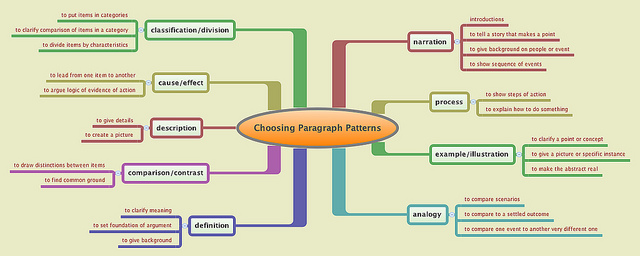6.15: Common Essay Structures
- Page ID
- 58332
- Examine the structure and organization of common types of essays
Suggested Essay Structure
Some common layouts for essay organization are listed below.
Argumentative Essay
Recall that in an argumentative essay, you are asked to take a stance about an issue. One effective way to argue a point can be to present the opposing view first, usually in your introduction paragraph, then counter this view with stronger evidence in your essay. You can also explain your argument and claims, then address the opposing view at the end of your paper, or you could address opposing views one at a time, including the rebuttal throughout your paper.
Argumentative Essay: Block Format
- Introduction
- Background information on topic
- Statement of your position on the topic (thesis)
- Overview of arguments to be presented (structure)
- Body paragraphs
- paragraph 1
- Topic sentence outlining first claim
- Sentences giving explanations and providing evidence to support topic sentence
- Concluding sentence – link to next paragraph
- paragraph 2 (or more)
- Topic sentence outlining second claim
- Sentences giving explanations and providing evidence to back topic sentence
- Concluding sentence – link to next paragraph
- paragraph 3: rebuttal
- Topic sentence outlining any possible counterarguments
- Provide evidence to refute counterarguments
- paragraph 1
- Conclusion
- Summary of the main points of the body
- Restatement of the position
Argumentative Essay: Rebuttal Throughout
This type of format works well for topics that have obvious pros and cons.
- Introduction and Thesis
- Body Paragraphs
- Paragraph 1
- Topic sentence outlining first rebuttal
- Opposing Viewpoint
- Rebuttal Argument
- Statistics and facts to support your side
- Transition
- Paragraph 2 (or more)
- Topic sentence outlining first rebuttal
- Opposing Viewpoint
- Rebuttal Argument
- Statistics and facts to support your side
- Transition
- Paragraph 1
- Conclusion
- Summary of the main arguments and counterarguments
- Restatement of the position
The Comparative Essay
Comparative essays are those that you have you compare, compare and contrast, or differentiate between things and concepts. In this structure, the similarities and/or differences between two or more items (for example, theories or models) are discussed paragraph by paragraph. Your assignment task may require you to make a recommendation about the suitability of the items you are comparing.
There are two basic formats for the compare/contrast essay: block or point-by-point. Block divides the essay in half with the first set of paragraphs covering one item, the other set of paragraphs covering the other item. So, if the writer is contrasting a Nikon DSLR with a similar priced Canon DSLR, the first set of paragraphs would cover Nikon and the next set would cover Canon. In point-by-point, the writer would cover the two items alternating in each point of comparison (see examples in outlines below).
Comparative Essay: Block Method
- Introduction and thesis
- Body Paragraph
- Nikon D7000
- Price
- Image Quality
- Shutter Speed
- The Auto-focus System
- Nikon D7000
- Body Paragraph
- Canon 60D
- Price
- Image Quality
- Shutter Speed
- The Auto-focus System
- Canon 60D
- Conclusion
Comparative Essay: Point-by-Point Method
- Introduction
- Body Paragraphs
- Price
- Nikon D7000
- Canon 60D
- Image Quality
- Nikon D7000
- Canon 60D
- Shutter Speed
- Nikon D7000
- Canon 60D
- The Auto-focus System
- Nikon D7000
- Canon 60D
- Price
- Conclusion
Cause and Effect Essay
Examples of cause and effect essays include questions that ask you to state or investigate the effects or outline the causes of the topic. This may be, for example, a historical event, the implementation of a policy, a medical condition, or a natural disaster. These essays may be structured in one of two ways: either the causes(s) of a situation may be discussed first followed by the effect(s), or the effect(s) could come first with the discussion working back to outline the cause(s). Sometimes with cause and effect essays, you are required to give an assessment of the overall effects of an event on a community, a workplace, an individual.
Cause and Effect Essay Format
- Introduction
- Background information on the situation under discussion
- Description of the situation
- Overview of the causes or effects to be outlined
- Body paragraphs
- Paragraph 1
- Topic sentence outlining first cause or effect
- Sentences giving explanations and providing evidence to support the topic sentence
- Concluding sentence – linking to the next paragraph
- Paragraph 2 (or more)
- Topic sentence outlining second cause or effect
- Sentences giving explanations and providing evidence to back topic sentence
- Concluding sentence – linking to the next paragraph
- Following body paragraphs
- These follow the same structure for as many causes or effects as you need to outline
- Paragraph 1
- Conclusion
- Summary of the main points of the body
- Conclusion, prediction or recommendation
Mixed Structure Assignment
Finally, consider that some essay assignments may ask you to combine approaches. You will rarely follow the above outlines with exactness, but can use the outlines and templates of common rhetorical patterns to help shape your essay. Remember that the ultimate goal is to construct a smooth and coherent message with information that flows nicely from one paragraph to the next.
This chart gives an idea of what different roles paragraphs can play in a mixed-structure essay assignment.



